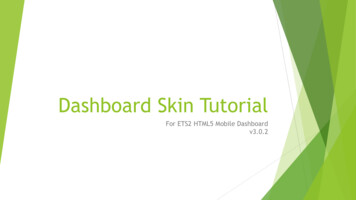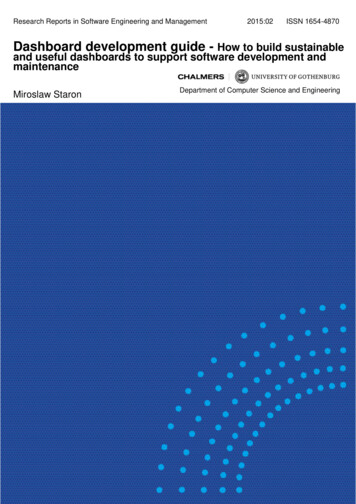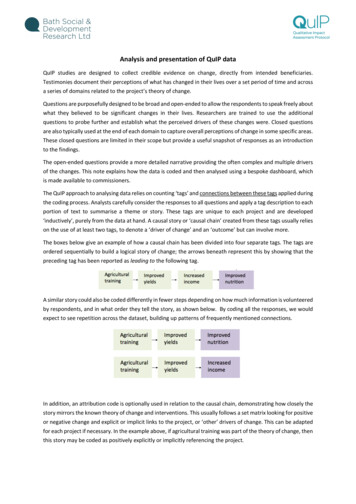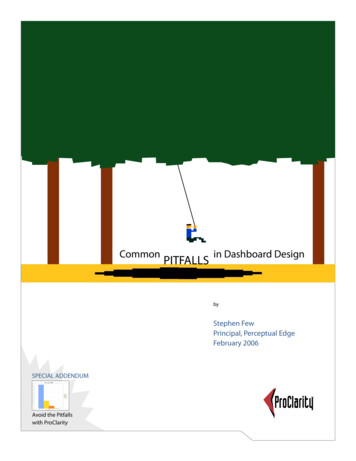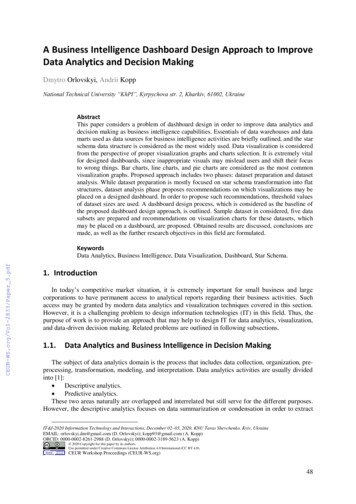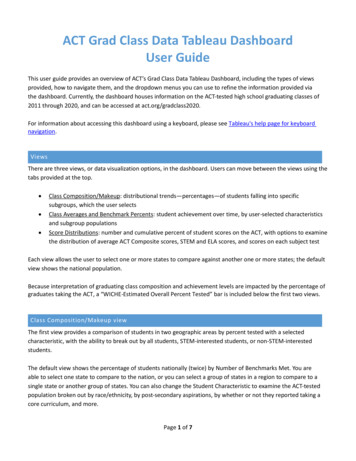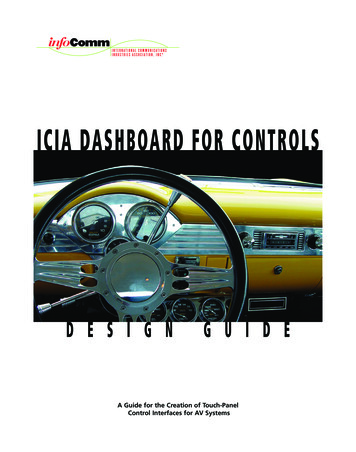
Transcription
ICIA DASHBOARD FOR CONTROLSD E S I G NG U I D EA Guide for the Creation of Touch-PanelControl Interfaces for AV Systems
FOREWORDAcknowledgementsApril 30, 2005The content in this document has been developed by industryvolunteer experts working on behalf of the InternationalCommunications Industries Association, Inc. (ICIA ), in support of the“Dashboard for Controls” effort. While the “Dashboard” is aboutmaking AV controls easier to use for the individual user, the processleading to its creation is about individuals working together for acommon cause. I hope you’ll find that cause, the Dashboard forControls and its various elements, to be of benefit to your work and theindustry as a whole.More than 50 ICIA member volunteers have contributed to the projectsince it began in the spring of 2001. Be it concept development, criticalreview, peer dialog or simply monitoring our activities, we owe thanksto all for the many, many contributions along the way. Space preventslisting all contributors; but perhaps you are one of those whocontributed. If so, I (and the Dashboard for Controls SteeringCommittee) thank you. I’d offer that you should take satisfaction onthose elements you can identify as “your own” and further considerthose with which you may have taken exception. You’ll be in goodcompany.Special thanks, and credit, go to dedicated individuals who over the lastyear have given extra, as steering committee members, in the sprint tothe “finish line.” Indulge me while I tell a few stories. Andrew Fauncewas at the ICIA End User Summit in March of 2002 when we firstconceived of the Dashboard project. At key points since then, he hascontinued to thoughtfully consider and contribute to shaping theDashboard. Rick Nimtz and Rem Remington “raised their hands” whenthe ICIA End User (Technology Manager) Council looked for subcommittee members to work on the Dashboard at our annual meeting.They’ve hung in there for years; and may think twice next time we’relooking for hands (just kidding)! Tim Cape and Dave Silberstein“returned my calls” in the summer of 2002 when I asked for theirparticipation in the then newly developed “cross-council” work groupfor Dashboard. Sometimes advocates, sometimes voices of reason,they’ve been there throughout, contributing with the wealth ofknowledge they have on this topic. Last, but not least, are GregMaderic and Howard Nunes, both of whom participated asrepresentatives of the fledgling ICIA Programmers Council. Starting“cold” on the project in fall of 2004, they immediately immersed into“all things Dashboard.” Writing, and editing, the DashboardReference, they lent their expertise to add a dimension to the projectthat I hadn’t let myself dream would be achievable.Participants of the Dashboard Steering CommitteeGreg Bronson, CTS-D, Steering Committee ChairTim Cape, CTS-DAndrew Faunce, CTSGreg MadericRichard Nimtz, Jr., CTSHoward NunesRem Remington, CTSDavid Silberstein, CTSParticipating Councils and CommitteeICAT CouncilIndependent Programmers CouncilManufacturers CouncilTechnology Managers CouncilSAVVI CouncilDashboard for Controls Working GroupGraphic DesignersRoberta J. MilitelloNetStrategiesThanks go to ICIA, and its skilled staff, for providing a platform for thiswork to occur and shepherding the volunteer effort. If you believethere are errors or omissions in this work, or simply want to helpfurther develop the concepts, please contact the ICIA membershipdepartment. We welcome your input.Greg Bronson, CTS-DChair, Dashboard for Controls Working GroupClassroom Technology Project Leader, Cornell UniversityForeward/Acknowledgements – 1
ICIA DASHBOARD FOR CONTROLSTOUCH PANELS AND CONTROL SCREENSDESIGN GUIDEOverviewNote: This document is intended to complement the ICIA Dashboard forControls Design Reference document. The purpose of the Design Reference,and this Design Guide document, is to help guide the creation of Pro AVtouch panel controls to promote intuitive end user operation ofprofessionally installed AV systems.The “Dashboard for Controls,” uses the basic premise that operation of aprofessionally-installed AV presentation system should be as easy to operateas driving a car. By way of standardization on some basics of user interfacedesign and identification of fundamental AV system functions, theenvironment of the future will increase end user confidence that the mostfrequently used functions will “look and feel” like others they havepreviously used. Advanced features or specialized systems will continue to beserved by custom interfaces unique to the application and thus restricted toadvanced users.Using the car dashboard as a metaphor, the ICIA Dashboard for Controlsembraces the following: It is assumed that end users may need to be trained on the system priorto first use. However, after that first use, and by exposure to similar“Dashboard” implementations, a user will rapidly gain confidence (bylearned experience and exposure of similar implementations) for whatto expect in other Dashboard observant systems. Like the automotive dashboard, the Dashboard for Controls embracesthe uniqueness of application and style of the implementers. Whendesigning with this guideline, control systems programmers havesufficient latitude to create “signature” control interface products.Some controls may look very utilitarian, while others may present arefined graphic appeal.This version of the Dashboard Templates is intended specifically for the classof control panels in the 10” to 18” range. However, we acknowledge thatmany of these recommendations could be successfully adapted to larger orsmaller touch panels.2 – ICIA Dashboard for Controls Design Guide
THE TEMPLATEHelpPage Title andA: Global FunctionsorB: AV Source SelectUtilitiesA: AVSourceSelectorAV Device StatusGlobalFunctionsTransport Controlfor Selected DeviceAudioVolumeB: GlobalFunctionsExitor OffDashboard for Controls TemplateLEGEND:Page TitleTitle of the overall page reflecting the current mode of operation.HelpAccess to Help or Support functions. Leave blank or expand adjacent Global or SourceSelect functions if not used.Global FunctionsControl of Environmental and AV-related systems such as projection screen, lights, drapes,etc.UtilitiesAccess to advanced End-User or Technician functions. Leave blank or expand adjacentGlobal or Source Select functions if not used.AV Source SelectArea for selection of AV device to be displayed, previewed or controlled.AV Device StatusArea for the video preview and status of the currently selected device. This may be videopreview or other status such as current channel or connection status. This area can alsoindicate the currently selected input for multiple devices of the same type such as multiplePC video inputs displayed on a floor plan, for example.Transport Control Controls for the currently selected AV device. Expand upward if more area required.Audio VolumeAudio volume and mute functions for speech, program or other audio signals. Expandupward if more area required.Exit or OffExit current mode and/or shut down down the system. This area can include access to othersupport functionsTemplate – 3
APPLYINGTHETEMPLATEThe template shows the relative positioning of functional areas as describedin the Legend for laying out AV control devices (i.e., touchpanels and webinterfaces) which has been endorsed by the ICIA Dashboard for Controls subcommittee.In applying these to your AV control projects, we’d alsoencourage you to observe the principles outlined in the Dashboard forControl Design Reference (also available from ICIA). Two options areavailable for the template configuration: Option A is a western format left-to-right flow with AV source selecton the left and Global Functions at the top. Option B is a western top-down activity flow with AV Source Select atthe top and Global Functions on the left.In both cases, items that are likely to be the first (and impacting other,remaining choices) for AV operation are given highest priority (relative totop left corner).The template regions are intended to imply a relative guideline.Whilegeneral orientation and placement of each region is considered veryimportant, the amount of screen area allocated for each component mayvary from system to system. For example, if AV Transport Control needs morespace and AV Status can do with less, by all means make the shift in spaceusage accordingly.When specified, the Dashboard for Controls should be considered theminimum requirement for observing an industry accepted practice of layoutand implementation. In a contract, it encompasses only the conformance tothe relative layout of the areas identified in the template. The Dashboard isnot a “button by button” function matrix and it is not a standard dictatingexact shape, color, and size of elements within the interface. The metrics anddesign of these elements must be specified separately within the contract. Assuch, each implementation of the Dashboard relies heavily on the processand knowledge of skilled professionals.We encourage you to consider using the Dashboard for Controls (DesignReference and Design Guide) for your project(s) and hope you’ll find it to beeasy to use and apply. We believe that the more the Dashboard is applied,the more end users will gain familiarity and confidence in AV controlscustomized and built for their special needs.Thank you,ICIA Dashboard for Controls Steering Committee4 – ICIA Dashboard for Controls Design Guide
About ICIAThe International Communications Industries Association Inc. (ICIA) is the premier trade association for the professionalaudiovisual (AV) communications industry worldwide. ICIA is the founder of InfoComm International Inc. , the conference andtrade exposition for audiovisual communications professionals who come to learn about the latest technologies and availableservices as well as new and alternative applications. As a key industry event, InfoComm is the educational and interactivemarketplace for manufacturers, distributors, dealers, systems integrators, rental and staging companies, independentrepresentatives, independent design consultants, architects, facilities managers, engineers, presentations designers and endusers, including AV and IT professionals, sales and marketing staff, meeting planners and purchasers. InfoComm attracts a broadspectrum of market sectors, including business, government, military, education, religion, health care, entertainment andconventions. More information is available at www.infocomm.org.ICIA is the industry leader in education and certification for AV professionals. The industry standard for professional expertise isICIA's certified technology specialist (CTS) designation. Companies that achieve a minimum level of certified staff members areeligible to become certified through the Certified AudioVisual Solutions Provider (CAVSP) program. These companies participatein ICIA’s industry awareness campaign, AVolution (see www.AVolution.info), which promotes the professionalism of the AVindustry. ICIA also offers information services including Market Intelligence, news, and InfoComm iQ, an online database of over80,000 AV products.Visit www.infocomm.org for news and information gathered from industry sources and publications.Contact ICIA at 800/659-7469 or 703/273-7200 for more information.
2 - ICIA Dashboard for Controls Design Guide ICIA DASHBOARD FOR CONTROLS TOUCH PANELS AND CONTROL SCREENS DESIGN GUIDE Overview Note: This document is intended to complement the ICIA Dashboard for Controls Design Reference document. The purpose of the Design Reference, and this Design Guide document, is to help guide the creation of Pro AV
